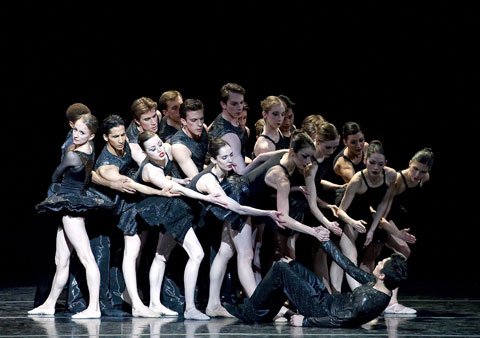
|
In silence a man slowly pushes a large, light-filled box across a dark stage. The box is bigger than an outhouse and smaller than a garage, and the light shows through only one side. The man steps away and does a few robotic stretches and moonwalks. He returns to the box, feeling his way along its side until he comes to a strip of paneling near the corner. He scratches on the box. A door opens and a ballerina steps out in a spill of bright light.This is the opening scene of Boston Ballet's evening-length dance by Jorma Elo (at the Opera House through April 3). Rather than a new work, it's a compilation of excerpts from previous Elo ballets, and rather than carrying a title, it's dubbed Elo Experience, as if it were already an institution. I guess the company imagines us attending it regularly, like going to symphony or school.
Shortly after the first encounter between the ballerina (Larissa Ponomarenko) and the robot (Jeffrey Cirio), Experience deploys the rest of its arsenal. Out of nowhere, Tchaikovsky's Piano Concerto No. 1 detonates on our ears. Hundreds of dancers (well, only 24) flood the stage, do some mass port de bras, leave, and start coming back in small groups. All these dance preliminaries happen before Tchaikovsky gets through his introduction. The box has disappeared. Large screens hanging high in the wings begin to fill with light.
Elo Experience is a two-hour showcase of devastating dancing, stunning theatrical effects (lighting by John Cuff, costumes by Charles Heightchew, scenery by Benjamin J. Phillips), chunks of music, and a running absurdist narrative between Ponomarenko and Cirio. It took me back almost 25 years, to the astounding and at the time alienating first US performances of William Forsythe's Artifact, which used the same elements to shake up our ideas of ballet. Forsythe inaugurated a new ballet æsthetic of souped-up virtuosity and anti-heroics that often conveys some existential notion about what it means to be dancing, or to be living. Elo's idea is to give the audience as much physical thrill as it can stand, avoid focusing attention on any one dancer or dance activity, and relieve us of the responsibility for making a rational whole of it. He cultivates dancing as simply a disappearing but endlessly renewable pleasure.
Experience has eight sections from earlier Elo dances, and seven linking "Tchaikovsky" interludes featuring Ponomarenko and Cirio. Both wearing body mics, they carry on a conversation of non-sequiturs. He hurtles around her at 50 mph. She counters with oblique remarks in English and Russian, and high nervous laughter.
Maybe they're a couple on the verge of a domestic break-up; maybe each would like to convert the other to his or her special way of moving. He does dazzling balletic leaps and maneuvers; she jolts into stiff angularities. The fluctuating population of dancers who back them up also toggle between balletic and robotic moves, and the music lurches among tracks of Tchaikovsky, Vivaldi, Bernard Herrmann, and the intermittent notes of an "erased" piano composition.